Johann Bernoulli was an acknowledged genius–and he acknowledged it of himself. Some flavor of his character can be seen in his opening lines of one of the most famous challenges in the history of mathematics—the statement of the Brachistrochrone Challenge.
“I, Johann Bernoulli, address the most brilliant mathematicians in the world. Nothing is more attractive to intelligent people than an honest, challenging problem, whose possible solution will bestow fame and remain as a lasting monument.”
Of course, he meant his own fame, because he thought he already had a solution to the problem he posed to the mathematical community of the day.
The Problem of Fastest Descent
The problem posed by Johann Bernoulli was the brachistochrone (Gk: brachis + chronos) or the path of fastest descent.
Galileo had attempted to tackle this problem in his Two New Sciences and had concluded, based on geometric arguments, that the solution was a circular path. Yet he hedged—he confessed that he had reservations about this conclusion and suggested that a “higher mathematics” would possibly find a better solution. In fact he was right.
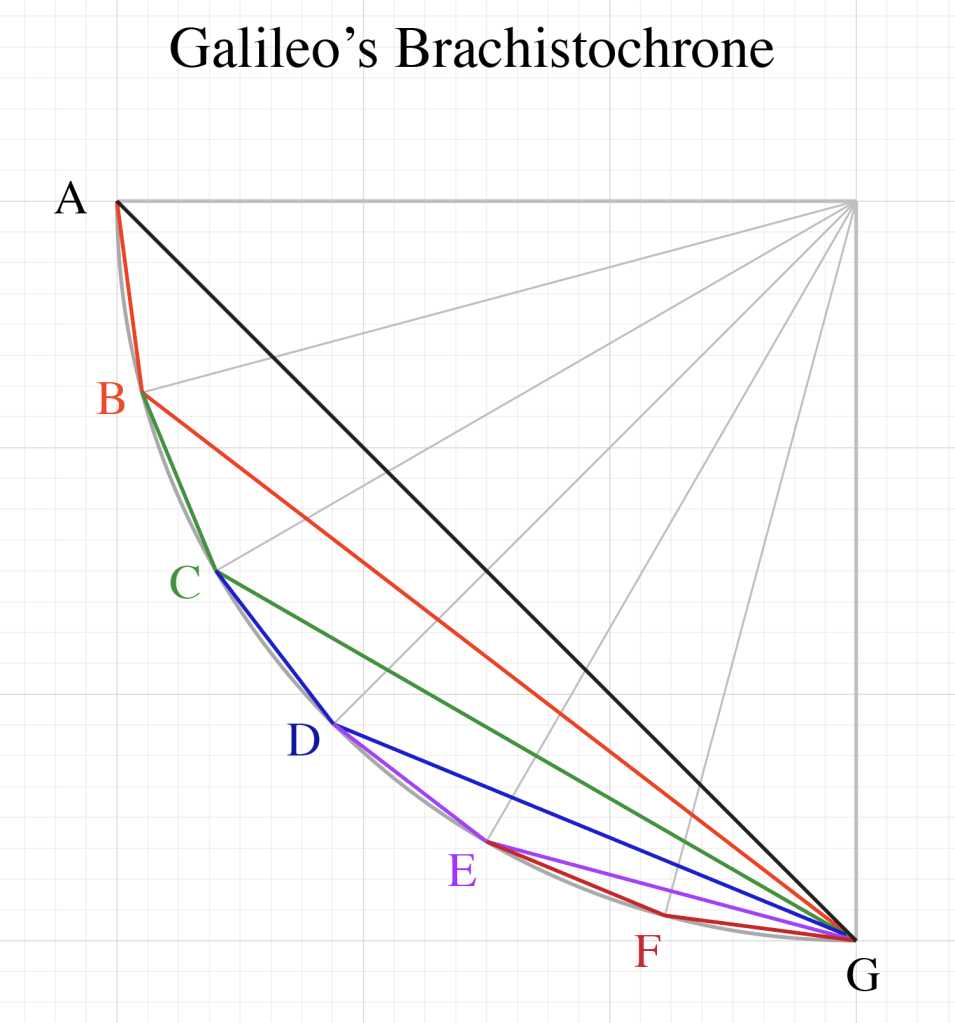
Fig. 1 Galileo considered a mass falling along different chords of a circle starting at A. He proved that the path along ABG was quicker than along AG, and ABCG was quicker than ABG, and ABCDG was quicker than ABCG, etc. In this way he showed that the path along the circular arc was quicker than any set of chords. From this he inferred that the circle was the path of quickest descent—but he held out reservations, and rightly so.
In 1659, when Christiaan Huygens was immersed in the physics of pendula and time keeping, he was possibly the first mathematician to recognize that a perfect harmonic oscillator, one whose restoring force was linear in the displacement of the oscillator, would produce the perfect time piece. Unfortunately, the pendulum, proposed by Galileo, was the simplest oscillator to construct, but Huygens already knew that it was not a perfect harmonic oscillator. The period of oscillation became smaller when the amplitude of the oscillation became larger. In order to “fix” the pendulum, he searched for a curve of equal time, called the tautochrone, that would allow all amplitudes of the pendulum to have the same period. He found the solution and recognized it to be a cycloid arc.
On a cycloid whose axis is erected on the perpendicular and whose vertex is located at the bottom, the times of descent, in which a body arrives at the lowest point at the vertex after having departed from any point on the cycloid, are equal to each other…
His derivation filled 16 pages with geometric arguments, which was not a very efficient way to derive the thing.
Almost thirty years later, during the infancy of the infinitesimal calculus, the tautochrone was held up as a master example of an “optimal” solution whose derivation should yield to the much more powerful and elegant methods of the calculus. Jakob Bernoulli, Johann’s brother, succeeded in deriving the tautochrone in 1690 using the calculus, using the term “integral” for the first time in print, but it was not at first clear what other problems could yield in a similar way.
Then, in 1696, Johann Bernoulli posed the brachistrochrone problem in the pages of Acta Eruditorum.

Acta Eruditorum
The Acta Eruditorum was the German answer to the Proceedings of the Royal Society of London. It began publishing in Leipzig in 1682 under the editor Otto Mencke. Although Mencke was the originator, launching and supporting the journal became the obsession of Gottfried Lebiniz, who felt he was a hostage in the backwaters of Hanover Germany but who yearned for a place on the world stage (i.e. Paris or London). By launching the continental publication, the Continental scientists had a freer voice without needing to please the gate keepers at the Royal Society. And by launching a German journal, it gave German scientists like Leibniz (and the Bernoullis and Euler, and von Tschirnhaus among others) a freer voice without censor by the Journal des Savants of Paris.

The Acta Eruditorum was almost a vanity press for Leibniz. He published 13 papers in the journal in its first 4 years of activity starting in 1682. In return, when Leibniz became embroiled in the priority dispute with Newton over the invention of the calculus, the Acta provided loyal support for Leibniz’ side just as the Proceedings of the Royal Society gave loyal support to Newton. In fact, the trigger that launched the nasty battle with Newton was a review that Leibniz wrote for the Acta in 17?? [Ref] in which he presented himself as the primary inventor of the calculus. When he failed to give due credit, not only to Newton, but also to lesser contributors, they fought back by claiming that Leibniz had stolen the idea from Newton. Although a kangaroo court by the Royal Society found in favor of Newton, posterity gives most of the credit for the development and dissemination of the calculus to Leibniz. Where Newton guarded his advances jealously and would not explain his approach, Leibniz freely published his methods for all to see and to learn and to try out for themselves. In this open process, the Acta was the primary medium of communication and gets the credit for being the conduit by which the calculus was presented to the world.
Although the Acta Eruditorum only operated for 100 years, it stands out as the most important publication for the development of the calculus. Leibnitz published in the Acta a progressive set of papers that outlined his method for the calculus. More importantly, his papers elicited responses from other mathematicians, most notably Johann Bernoulli and von Tschirnhaus and L’Hopital, who helped to refine the methods and advance the art. The Acta became a collaborative space for this team of mathematicians as they fine-tuned the methods as well as the notations for the calculus, most of which stand to this day. In contrast, Newton’s notations have all but faded, save the simple “dot” notation over variables to denote them as time derivatives (his fluxions). Therefore, for most of continental Europe, the Acta Eruditorum was the place to publish, and it was here that Johann Bernoulli published his famous challenge of the brachistochrone.
The Competition
Johann suggested the problem in the June 1696 Acta Eruditorum
Following the example set by Pascal, Fermat, etc., I hope to gain the gratitude of the whole scientific community by placing before the finest mathematicians of our time a problem which will test their methods and the strength of their intellect. If someone communicates to me the solution of the proposed problem, I shall publicly declare him worthy of praise
Given two points A and B in a vertical plane, what is the curve traced out by a point acted on only by gravity, which starts at A and reaches B in the shortest time
The competition was originally proposed for 6 months, but it was then extended to a year and a half. Johann published his results about a year later, but not without controversy. Johann had known that his brother Jakob was also working on the problem, but he incorrectly thought that Jakob was convinced that Galileo had been right, so Johann described his approach to Jakob thinking he had little to fear in the competition. Johann didn’t know that Jakob had already taken an approach similar to Johann’s, and even more importantly, Jakob had done the math correctly. When Jakob showed Johann his mistake, he also ill-advisedly showed him the correct derivation. Johann sent off a manuscript to Acta with the correct derivation that he had learned from Jakob.
Within the year and a half there were 4 additional solutions—all correct—using different approaches. One of the most famous responses was by Newton (who as usual did not give up his method) but who is reported to have solved the problem in a day. Others who contributed solutions were Gottfried Leibniz, Ehrenfried Walther von Tschirnhaus, and Guillaume de l’Hôpital’s. Of course, Jakob sent in his own solution, although it overlapped with the one Johann had already published.
The Solution of Jakob and Johann Bernoulli
The stroke of genius of Jakob and Johann Bernoulli, accomplished in 1697 only about 20 years after the invention of the calculus, was to recognize an amazing analogy between mechanics and light. Their insight foreshadowed Lagrange by a hundred years and William Rowan Hamilton by a hundred and fifty. They did this by recognizing that the path of a light beam, just like the trajectory of a particle, conserves certain properties. In the case of Fermat’s principle, a light ray refracts to take the path of least time between two points. The insight of the Bernoulli’s is that a mechanical particle would behave in exactly the same way. Therefore, the brachistrochrone can be obtained by considering the path that a light beam would take if the light ray were propagating through a medium with non-uniform refractive index to that the speed of light varies with height y as

Fermat’s principle of least time, which is consistent with Snell’s Law at interfaces, imposes the constraint on the path
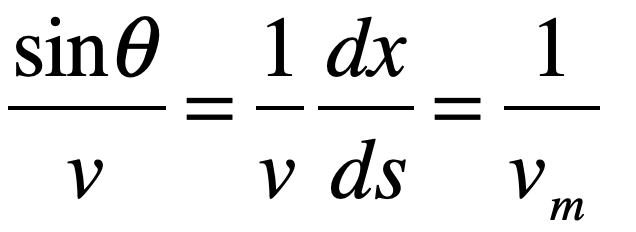
This equation for a light ray propagating through a non-uniform medium would later become known as the Eikonal Equation. The conserved quantity along this path is the value 1/vm. Rewriting the Eikonal equation as

it can be solved for the differential equation
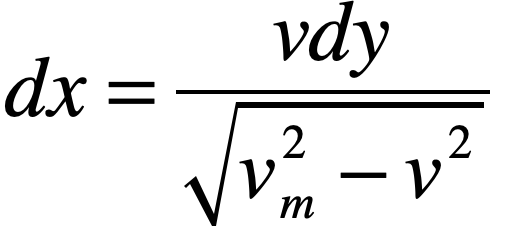
which those in the know (as certainly the Bernoullis were) would know is the equation of a cycloid. If the sliding bead is on a wire shaped like a cycloid, there must be a lowest point for which the speed is a maximum. For the cycloid curve of diameter D, this is

Therefore, the equation for the brachistochrone is
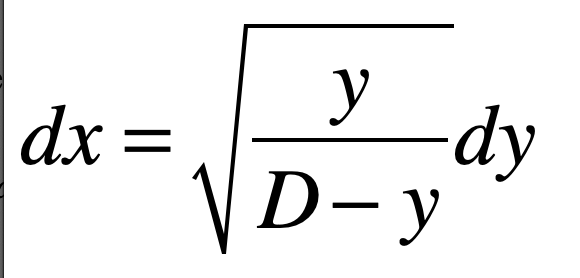
which is the differential equation for an inverted cycloid of diameter D.

Fig. 4 A light ray enters vertically on a medium whose refractive index varies as the square-root of depth. The path of least time for the light ray to travel through the material is a cycloid—the same as for a massive particle traveling from point A to point B.
Calculus of Variations
Variational calculus had not quite been invented in time to solve the Brachistochrone, although the brachistochrone challenge helped motivate its eventual development by Euler and Lagrange later in the eighteenth century. Nonetheless, it is helpful to see the variational solution, which is the way we would solve this problem if it were a Lagrangian problem in advanced classical mechanics.
First, the total time taken by the sliding bead is defined as

Then we take energy conservation to solve for v(y)
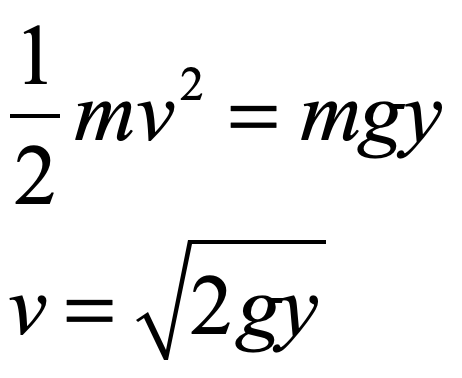
The path element is

which leads to the expression for total time
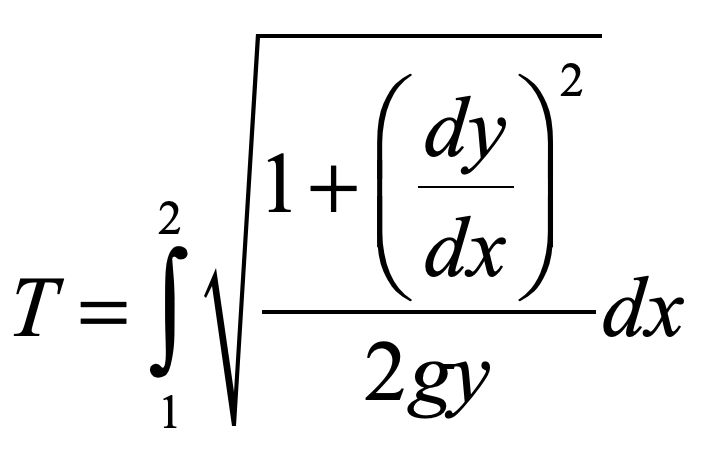
It is the argument of the integral which is the quantity to be varied (the Lagrangian)
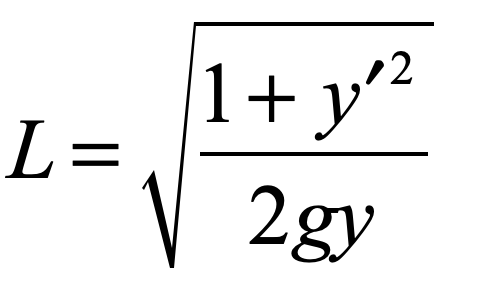
which can be inserted into the Lagrange equation

This has a simple first integral
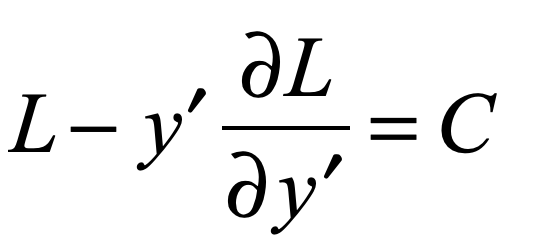
This is explicitly solved

Once again, it helps to recognize the equation of a cycloid, because the last line can be solved as the parametric curves
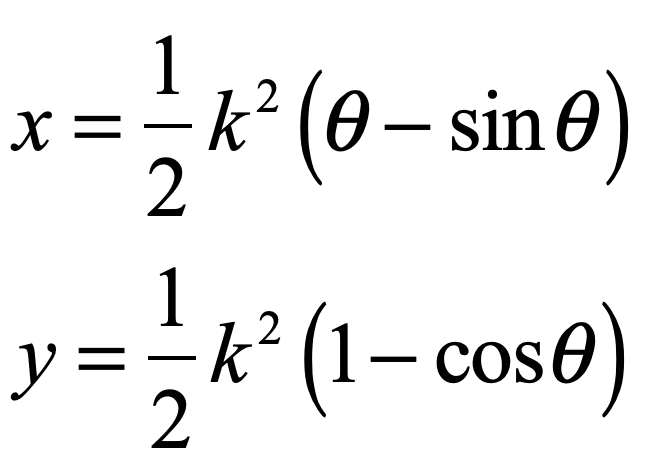
which is the cycloid curve.
References
C. B. Boyer, The History of the Calculus and its Conceptual Development. New York: Dover, 1959.
J. Coopersmith, The lazy universe : an introduction to the principle of least action. Oxford University Press, 2017.
D. S. Lemons, Perfect Form: Variational Principles, Methods, and Applications in Elementary Physics. Princeton University Press, 1997.
Wikipedia: The Brachistrochrone Curve
W. Yourgrau, Variational principles in dynamics and quantum theory, 2d ed.. ed. New York: New York, Pitman Pub. Corp., 1960.

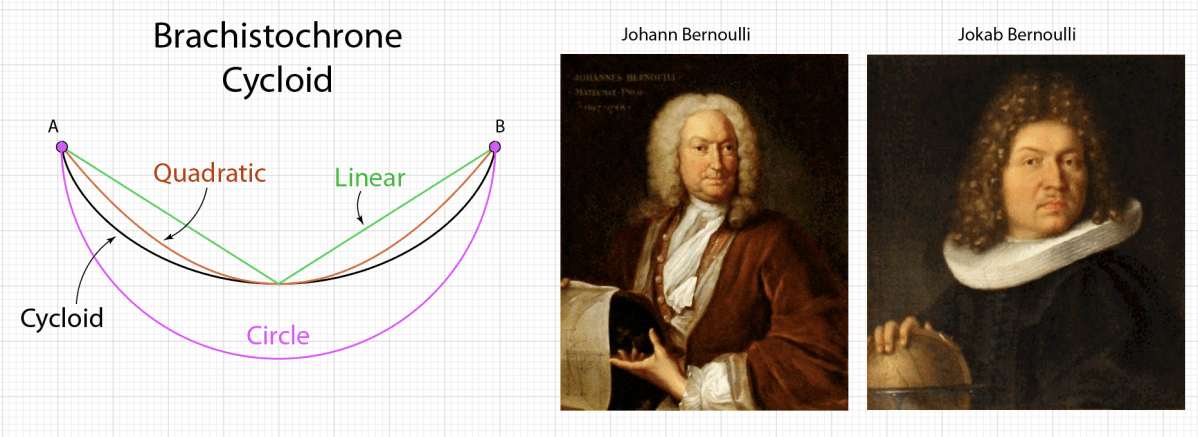
[…] Johann Bernoulli’s Brachistochrone […]
LikeLike
[…] Johann Bernoulli’s Brachistochrone […]
LikeLike
[…] Johann Bernoulli’s Brachistochrone […]
LikeLike
[…] Johann Bernoulli’s Brachistochrone […]
LikeLike